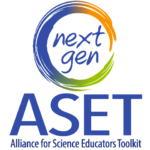
Making Explicit Connections:
SEPs and DCIs
Overview
An important feature of lessons and units that align with the vision of three-dimensional science teaching, is that explicit and meaningful connections are made among the three dimensions.
“A coherent and consistent approach throughout grades K-12 is key to realizing the vision for science and engineering education embodied in the framework: that students, over multiple years of school, actively engage in science and engineering practices and apply crosscutting concepts to deepen their understanding of each field’s disciplinary core ideas.” (NRC, 2012, p. 2, emphasis added)
In the case of linking Science and Engineering Practices (SEPs) with Disciplinary Core Ideas (DCIs), the larger question to be asked is: How is your lesson or unit making explicit connections between the SEPs and DCIs targeted in instruction?
Instructions for the 3D Map
- List specific examples from your lesson or unit where students are making explicit connections between particular components of SEPs and particular components of DCIs. This should include when students are using SEPs to explore DCIs as well as when you explicitly instruct on or consider the connection between them.
- Describe your reasoning for how the SEP and DCI are linked in each example.
Guiding Questions
In identifying explicit connections between SEPs and DCIs in your lesson or unit, you should ask yourself:
- How is student engagement in the particular component of the chosen SEP helping to deepen their knowledge the chosen component of a DCI?
- Example: Students use a model (SEP #2) to describe how mutations may affect protein structure and function (DCI LS3.B)
- Example: Students interpret graphical displays of data (SEP #4) to describe the relationships of kinetic energy to the mass of an object (DCI PS3.A)
- Example: Students draw a model to organize and communicate their ideas about evaporating particles and water molecule movement regarding the phenomena of water evaporating (Schwarz et al., 2009)
- How is students’ deepening knowledge of particular DCIs helping to develop their ability to engage in particular SEPs?
- Example: Students using their deepening knowledge of a particular DCI to revise a model (SEP #2).
- Example: As students learn about properties of matter and energy, they improve their models to describe changes in particle motion, temperature, and states of matter that occurs during water evaporation.
- Are the connections between SEPs and DCIs made explicit to the students through instruction?
References
National Research Council. (2012). A Framework for K-12 Science Education: Practices, Crosscutting Concepts, and Core Ideas. Committee on a Conceptual Framework for New K-12 Science Education Standards. Board on Science Education, Division of Behavioral and Social Sciences and Education. Washington, DC: The National Academies Press.
